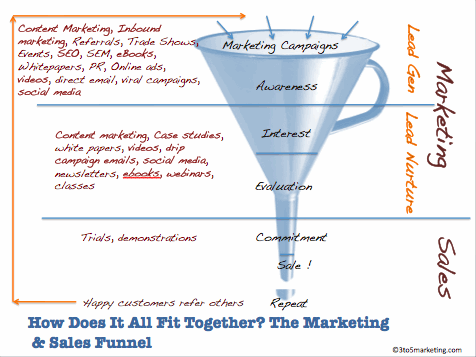
Tactics like search engine optimization for schools, email marketing, and paid advertising will reach a targeted audience. Once you command an audience’s attention, however, you must keep it and direct it towards taking action. To direct parents and students towards enrollment, you’ll need to employ a marketing funnel.
What is a marketing funnel, and how can it assist a school in improving enrollment rates? In this guide, you’ll learn exactly how to build a marketing funnel to achieve and exceed your enrollment goals this year.
What is a Marketing Funnel?
Visualize a marketing funnel as a funnel you’d use for cooking or filling a gas canister. For example, the top is wide to catch a large amount of substance, while the middle tapers to the narrow bottom. A funnel’s shape helps direct the substance into a targeted area.

When crafting a marketing funnel, it’s essential to follow a basic AIDA format as a guide. AIDA format stands for attention, interest, desire, and action. Specifically, grab the subject’s attention, intrigue them, build their desire for the project, then call them to action.
Unlike a real funnel, however, a marketing funnel leaks. By the end of the funnel, there will be much fewer people than when the audience entered. As a consequence, you’ll lose the attention of many but convert the truly interested customers.
Different Types of Funnels
Diversity among marketing funnels has made this marketing strategy both challenging and innovative. Some marketing funnels are digital marketing funnels, while others are a hybrid of marketing tactics. To fully take advantage of marketing funnels for your institution, consider setting up a few different types.
For instance, you can choose to create a lead magnet funnel. Lead magnets are resources offered to a target audience to draw them in and engage with your paid goods and services. If a prospective student wants a guide to choosing the best school, they can access this resource by exchanging it for contact information.
As a result, you’ll build leads on interested students, which you can nurture to increase enrollment.
Another type of marketing funnel is a list-building funnel. Using a list-building funnel, you can encourage interested students to sign up for an account on your school website by giving their email addresses, which you can then use for email marketing campaigns.
Webinar funnels are another way of offering a resource to parents and students in exchange for contact information. For example, you could hold a webinar about the programs that your school offers and build a great email list of prospective students who would be interested in those programs.
In a different realm, social media marketing funnels happen almost entirely on a school’s social media accounts. For example, prospective students will discover a school, assess whether they want to attend, then follow the prompts to enroll all through social media posts and ads. Finally, the school’s account will nurture loyalty by continuing to provide valuable content.
Schools can also greatly benefit from video sales funnels, which interest and convert prospective students through a series of videos. Another option is to choose basic email funnels, which provide informational marketing content through emails to convert.
Marketing Funnel Stages
Marketing funnels have several stages that guide prospective customers along the way. Depending on the type of marketing funnel, a marketer will determine what strategies are engaged at each stage. On a basic level, however, marketing funnels will always follow general guidelines.
Each marketing funnel has a top, middle, and bottom. The goal of the top of the marketing funnel is to grab attention from a wide range of prospects. While prospects are in this stage, they are gaining awareness of your institution.
In this stage, schools could implement paid advertising, recruiter visits, and other digital marketing tactics. Another very popular top-funnel strategy is content marketing. With this tactic, schools could create ebooks or write blogs to capture the attention of a wider audience.
Once marketers have captured attention, they must nurture interest. In this stage, prospects are considering a school and must be thoroughly convinced to enroll. Middle-funnel marketing tactics narrow in on prospects who have shown interest and further involve them with social media engagement, email marketing, and landing pages.
At the bottom of the funnel, the marketing strategy is to convert interested prospects. In other words, these strategies must directly lead prospects from interest to enrollment. For schools, bottom-funnel marketing tactics include financial aid consultations, one-on-one recruiter meetings, and school visits.
Benefits of a Marketing Funnel
Using the marketing funnel tactic is beneficial due to its requirement that marketers plan how they will lead prospects from awareness to conversion. Instead of haphazardly posting on social media or sending out emails, schools can plan and implement a solid strategy.
Planning a marketing funnel will also allow a marketer to evaluate the effectiveness of each step taken towards conversion and identify areas that need improvement. Analyzing results at each funnel stage allows marketers to assess which tactic is not effective and why.
Setting systems in place for your marketing funnel will also be easier once you finalize a marketing funnel. Schools can automate campaigns as a part of the marketing funnel, such as an email drip campaign, that will be triggered automatically according to goals reached. Therefore, marketing strategies will be streamlined, and schools will save time and money.
Overall, a marketing funnel will help convert prospective students at a large scale and improve enrollment.
What Can You Use a Funnel For?
In more detail, a marketing funnel in the world of education has all prospective students and parents at the top. At the bottom of the funnel, schools are converting extremely interested students and parents by directing them towards enrollment.
To better educate how schools can utilize marketing funnels, here is an example:
A private school has decided to offer a webinar as part of a webinar marketing funnel. The school’s goal is to increase enrollment specifically for their music department. All prospective students and parents are invited to attend a talk about how practicing music at the private school improves developing minds’ ability to learn.
To build a list of leads, the school requires that attendees input their contact information, such as their name and email address, to receive a link to the webinar. In this webinar, the host ties in the topic with how the private school’s music department integrates learning with playing music.
Now that the school has a list of leads regarding prospective students interested in the music department, the leads can be used for an email drip campaign. An email drip campaign will steadily email prospects with information about the music department, the school, and deadlines for financial aid and enrollment. It might even lead the prospect to visit their own personal account on a portal with access to resources and communication with school administration.
Throughout the middle of the funnel, the marketing campaign will get more targeted and lead the prospects to take action at the bottom. Prospects who have visited their personal account and filled out more information or clicked on resources could get a personal email from a recruiter. Further, the recruiter could ask to set up a one-on-one meeting to discuss enrollment.
Meeting Marketing Funnel Goals for Education
While many schools have implemented a marketing strategy to improve enrollment, not many successfully create a marketing funnel. As a result, sections of the marketing funnel falter and stunt the rest of the funnel. For marketing funnels to work effectively, each section must fully function and target the correct audience.
With the intention of being successful in marketing right away, you should consider hiring a professional. Given that funnels are complicated and require intense attention to detail at every step, hiring a marketing professional with experience in funnels is the best choice.
Further, schools should not settle for any marketing agency. School marketing is in a niche of its own, so hiring a marketer with experience in the world of education is essential to achieving your goals. Otherwise, the marketer will not be familiar with your goals, language, or past efforts that have been successful.
Implement A Successful Marketing Funnel
Now that you know the answer to “what is a marketing funnel?” you can get started on implementing one for your school. With the aid of a professional marketing agency, your school will target the correct audience and market to them effectively to improve conversions.
VujaDay is a marketing agency with extensive experience in the world of education. By hiring us, you’ll ensure that your marketing strategy is perfectly tailored to school awareness and student enrollment. Speak with us to get started.



